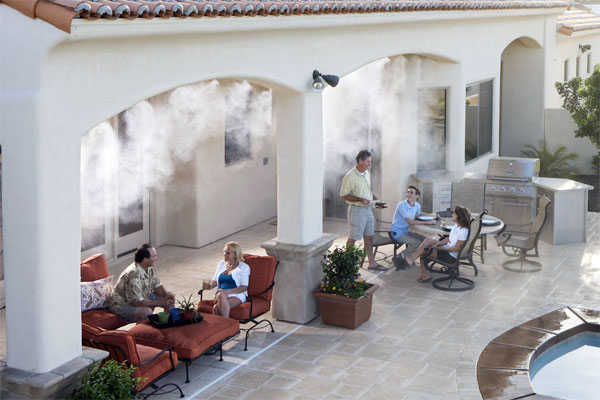Definition of Patio Misters
Patio misters, also known as outdoor misting systems, are a popular way to beat the heat during hot summer days and create an enjoyable outdoor living space. These systems utilize advanced technologies to lower the air temperature by evaporating water droplets into the atmosphere.
There are two types of patio misting systems- high-pressure misting systems and low-pressure misting systems. High-pressure systems have a psi of water pressure of 1000 or more and use brass nozzles to spray water through a high-pressure misting line system. Low-pressure misting systems, on the other hand, use a gravity-fed water pressure to create microdroplets of water through a low-pressure misting line system. In both systems, the smaller the water droplet, the more efficiently the misting process cools the air.
Patio misters work on the principle of evaporative cooling which is based on the properties of heat energy. The temperature of a gas is directly proportional to its pressure, so when water is sprayed into the air in fine droplets, it absorbs heat and evaporates into water vapor, thus reducing air temperature. The result is a cool mist of water that makes outdoor spaces more comfortable and enjoyable even in the extreme heat of summer.
Using a patio mister is an efficient way to cool your outdoor living space. The mist of water produced by this system has a maximum cooling effect, reducing the temperature by up to 30 degrees Fahrenheit. This means that you can enjoy your outdoor living space even in the heat of a humid climate.
Additionally, patio misting systems can be simple or complex, depending on the size and design of the outdoor area. In fact, even theme parks rely heavily on these systems to provide visitors with a cool and comfortable outdoor experience.
In conclusion, patio misters are a practical and effective solution for outdoor cooling. Whether you opt for a portable misting fan or a permanent outdoor misting system, the benefits of evaporative cooling are undeniable; with a drop in temperature of up to 30 degrees Fahrenheit, they can make all the difference in creating the perfect outdoor living space.
Overview of Benefits

Patio misting systems have been gaining popularity in recent years due to the many benefits they offer. These systems are designed to provide efficient and effective cooling for outdoor spaces, making them more comfortable and enjoyable even during the hottest months of the year.
One of the most notable benefits of using a patio mister is its ability to create a cool mist of water that can significantly reduce the temperature by up to 30 degrees Fahrenheit. This cooling effect is made possible by the principle of evaporative cooling, which uses water droplets to absorb heat and evaporate into water vapor, thus lowering the air temperature. This means that you can enjoy your outdoor living space without feeling hot and uncomfortable, even in dry and hot climates.
Another advantage of using a patio mister is its versatility. These systems come in different types, ranging from high-pressure misting systems that use brass nozzles to spray water through a high-pressure misting line system to low-pressure misting systems that produce microdroplets of water through a gravity-fed water pressure. This means that you can choose a system that is best suited for your outdoor space, whether it is a small patio area or a large outdoor entertainment area.
Patio misting systems are also easy to install and operate, making them a convenient addition to any outdoor living space. They can be integrated into existing outdoor structures or installed as a standalone system. They also require minimal maintenance and upkeep, with only occasional cleaning and replacement of water supply as needed.
In addition, patio misting systems are eco-friendly, using only a fraction of the water required by traditional cooling systems. The water droplets produced by these systems are also finer than those produced by traditional cooling systems, which means there are fewer water deposits and wet surfaces around your outdoor space.
Overall, investing in a patio misting system can enhance your outdoor living experience and provide you with a comfortable and enjoyable space to spend time in. From maximum cooling to efficient and eco-friendly operation, the benefits of using a patio mister are hard to ignore.
Outdoor Space
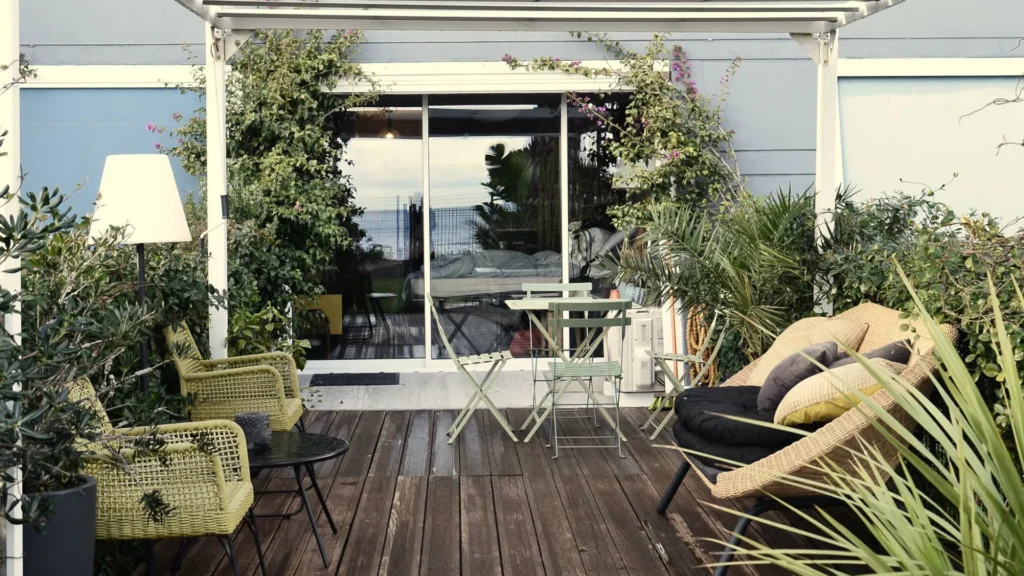
Outdoor space is an extension of your home, providing a space to relax, entertain, and enjoy the fresh air. It’s the perfect place to unwind after a long day or socialize with friends and family. With proper planning and design, you can create an outdoor living space that meets all your needs and enhances your home’s overall value.
One of the best ways to create an inviting outdoor space is by incorporating landscaping features. Trees, shrubs, and flowers can add color and texture to your outdoor area, making it feel more like a natural extension of your home. Plus, plants can provide privacy, shade, and even improve air quality.
Outdoor lighting is another important consideration. Not only does it add visual interest during the evening hours, but it also enhances safety and security. You can choose from a variety of lighting fixtures, including string lights, lanterns, and floodlights, to suit your needs and personal style.
If you live in an area with extreme heat or humidity, such as a desert or tropical climate, you may want to consider adding an evaporative cooling system. Patio misters and outdoor misting systems use water droplets to cool down the air temperature, making it more comfortable for you and your guests to enjoy your outdoor space.
When it comes to outdoor furniture, consider investing in high-quality pieces that are designed to withstand the elements. Outdoor furniture made from materials such as teak, wicker, and metal are durable and can last for years with proper care and maintenance.
Finally, don’t forget to add some personal touches to your outdoor space. Decorative accents such as throw pillows, outdoor rugs, and artwork can add a pop of color and personality to your outdoor living area. With a little creativity and planning, you can transform your outdoor space into a relaxing oasis that you’ll love spending time in.
Types of Outdoor Spaces Where Patio Misters Could be Used
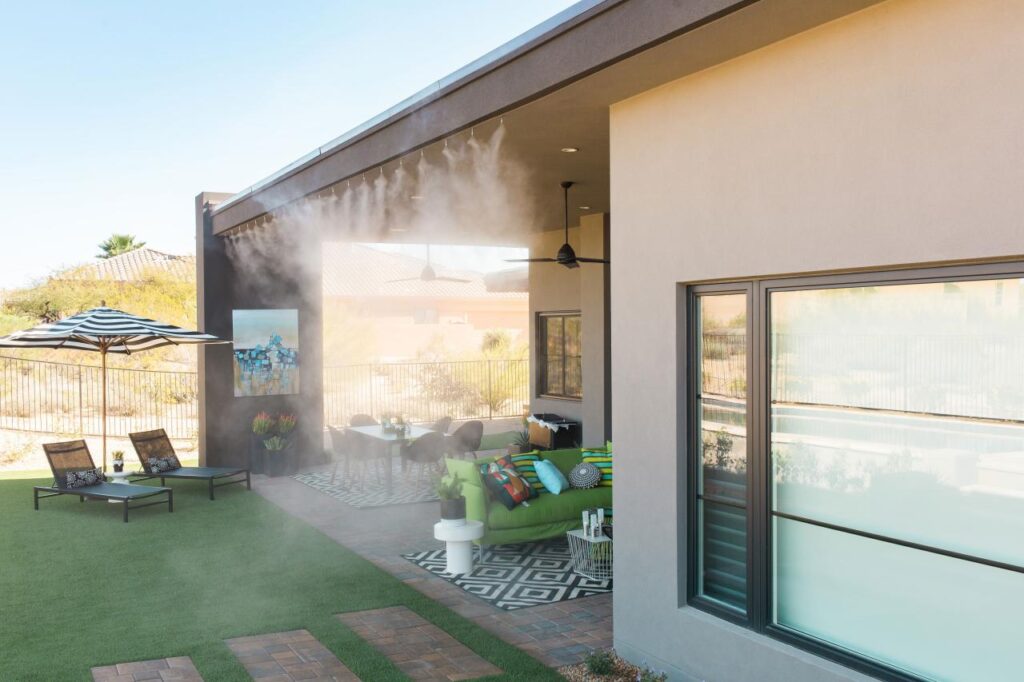
When the temperature starts to climb during the hot summer days, spending time outside can become unbearable. This is where outdoor misting systems come into the picture. Patio misters use water droplets to cool down the ambient air temperature, making it more comfortable for you and your guests to enjoy your outdoor space.
But what are the types of outdoor spaces where patio misters could be used? Here are a few examples:
1. Outdoor patios: One of the most common places to install patio misters is on an outdoor patio. Whether you have a small balcony or a spacious deck, patio misters can make your outdoor living space more enjoyable during the hot summer months.
2. Theme Parks: If you’ve ever been to a theme park during the summer, you know just how hot it can get. Many parks use high-pressure misting systems to cool down their guests. This not only helps keep visitors comfortable but also ensures they stay at the park longer, spending more money.
3. Restaurant Patios: Many restaurants with outdoor seating use patio misters to keep their customers cool and comfortable. This is especially important during the summer months when customers are more likely to choose an establishment with outdoor seating.
4. Backyards: If you have a backyard, you can install a portable misting fan or a low-pressure misting system to keep you and your family cool during outdoor activities. This could be especially useful for summer barbecues or outdoor gatherings.
5. Large Outdoor Events: Concerts, festivals, and other large outdoor events often use high-pressure misting systems to keep their attendees cool. This is important for the safety and comfort of the guests, as heat exhaustion and dehydration can quickly become a serious issue in a large crowd.
In conclusion, patio misters can be used in a variety of outdoor spaces to provide efficient cooling and make your outdoor activities more comfortable. Whether you’re looking to install a cooling system on your backyard patio or keep your guests comfortable at a large outdoor event, patio misters are a great choice.
Pros and Cons of Installing a Patio Misting System in an Outdoor Space
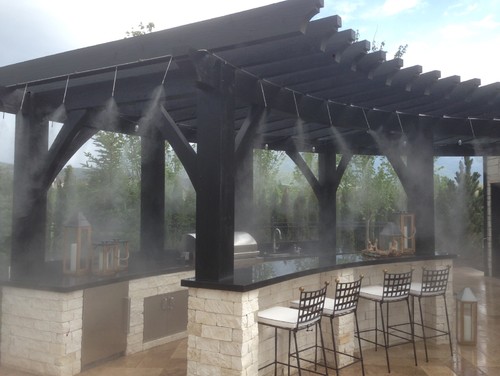
If you live in a hot and humid climate, you may be considering installing a patio misting system to help cool down your outdoor living space. But there are both pros and cons to be aware of before making a decision.
Pros:
1. Effective Cooling: Patio misting systems are designed to create a fine mist of water that evaporates quickly, which helps cool down the surrounding area. This can result in a drop in temperature of up to 30 degrees Fahrenheit, making it more comfortable to spend time outdoors during extreme heat.
2. Maximum Cooling with High-Pressure Systems: High-pressure misting systems are able to create a finer mist of water droplets that evaporate more quickly, resulting in even more efficient cooling. These systems are typically installed by professionals and can cover a larger outdoor space with more precision.
3. Versatility: Patio misting systems come in various forms, including low-pressure misting systems that can be installed by homeowners themselves, portable misting fans that can be moved around your outdoor space, and even mid-pressure misting systems that offer a balance between efficiency and affordability.
4. Energy Efficient: Patio misting systems do not consume as much energy as air conditioning units, making them a more sustainable and cost-effective option for outdoor cooling.
Cons:
1. Water Deposits: Continuous use of a patio misting system can result in a buildup of water deposits on nearby surfaces. This can be especially problematic if you have outdoor furniture or wooden decks that are susceptible to water damage.
2. Water Supply: Patio misting systems require a consistent source of water, which can be a challenge if you live in an area with water restrictions or low water pressure.
3. Risk of Slipping: The mist created by a patio misting system can make surfaces slippery, which could result in a potential slip-and-fall hazard.
4. High Costs for High-Pressure Systems: While high-pressure misting systems offer the most efficient cooling, they can also be expensive to install and maintain. Additionally, they require a professional installation, which can add to the overall costs.
In conclusion, while patio misting systems can be an effective way to cool down your outdoor living space, there are both pros and cons to consider. It ultimately comes down to your individual needs, budget, and the specific outdoor space you want to cool down. Regardless of which option you choose, a patio misting system can undoubtedly improve your outdoor experience during hot summer days.
How to Select the Right Patio Misting System for Your Outdoor Space
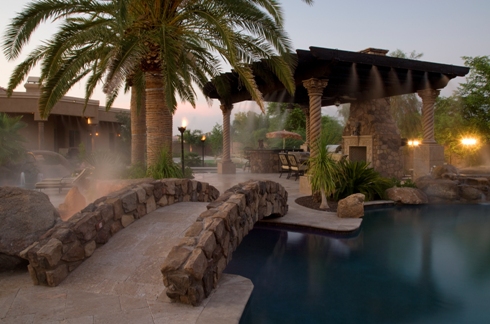
If you live in a hot and humid climate, then owning a patio misting system can be a lifesaver. These systems work by spraying a fine mist of water into the air, which then evaporates and cools the surrounding area. However, selecting the right patio misting system for your outdoor space can be a bit of a daunting task. Here are a few factors to consider when choosing a patio misting system:
1. Size and shape of your outdoor space:
The first thing you should consider is the size and shape of your outdoor space. A large space will require a high-pressure misting system that can cover a larger area with precision. Conversely, a small space may only require a low-pressure misting system or a portable misting fan.
2. Water supply and pressure:
Patio misting systems require a consistent water supply and pressure. Make sure that your source of water can handle the amount of water required by the system you choose. High-pressure systems require a higher psi (pounds per square inch) of water pressure, while low-pressure systems can operate on lower psi.
3. Climate and temperature:
Consider the climate and temperature of your location when choosing a patio misting system. High-pressure systems are best suited for hotter and more humid climates, while low-pressure systems are suitable for dryer and cooler climates.
4. Installation and maintenance:
Installation of high-pressure misting systems typically requires professional installation, while low-pressure systems can be installed by homeowners. Additionally, consider the maintenance requirements and costs associated with each system before making a decision.
5. Cost:
Finally, consider the cost of each system and your budget. High-pressure systems are typically more expensive to install and maintain, while low-pressure systems and misting fans are more affordable options.
In conclusion, selecting the right patio misting system for your outdoor space requires careful consideration of several factors. By keeping in mind the size and shape of your space, water supply and pressure, climate and temperature, installation and maintenance requirements, and cost, you can find the perfect patio misting system to keep you cool and comfortable during hot summer days.
Evaporative Cooling
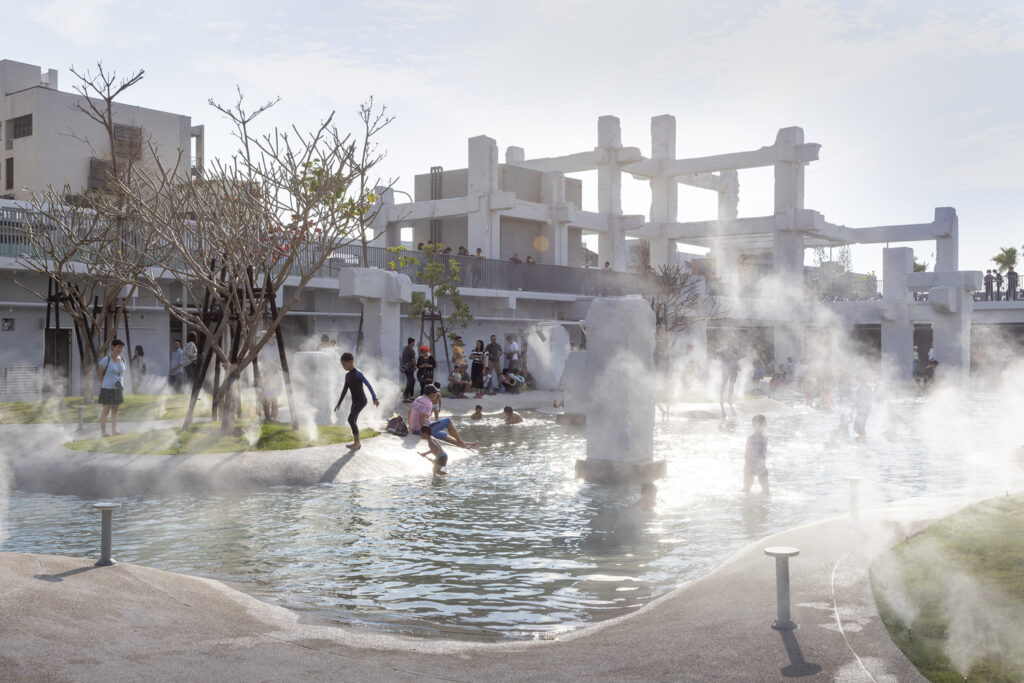
Evaporative cooling is a revolutionary technology that can provide efficient and effective cooling for outdoor living spaces. This innovative cooling technique utilizes the natural principles of water evaporation to produce cool air that can provide relief from the heat during hot summer days.
Evaporative cooling systems work by using high-pressure misting pumps to deliver a fine mist of water droplets into the air. As the water droplets vaporize, they absorb heat energy from the surrounding air, creating a cool and refreshing mist. This process reduces the ambient temperature of the surrounding area, providing a significant drop in temperature that can make the outdoor environment more comfortable and enjoyable.
One of the key benefits of evaporative cooling is its efficiency. Unlike traditional air conditioning systems that use a significant amount of electricity, evaporative cooling systems are highly energy-efficient and can reduce your energy consumption by up to 75%. This makes them an excellent choice for those who want to reduce their carbon footprint and save money on their energy bills.
Another advantage of evaporative cooling is that it is a natural and eco-friendly cooling solution. Unlike air conditioners, which rely on the use of harmful refrigerants that can contribute to environmental degradation, evaporative cooling systems utilize water vapor, which is a clean and renewable resource. Additionally, the water droplets produced by these systems can help to moisturize the air, providing a healthier and more comfortable environment for you and your family.
In addition to the benefits mentioned above, evaporative cooling systems are also highly customizable. There are a variety of different systems available on the market, including high-pressure misting systems and low-pressure misting line systems. These systems can be tailored to suit the specific needs of your outdoor space, ensuring maximum cooling efficiency and effectiveness.
Overall, evaporative cooling is an excellent choice for those looking to create a comfortable and enjoyable outdoor living space. By utilizing the principles of water evaporation, these systems can provide effective cooling while also being energy-efficient, eco-friendly, and highly customizable. Whether you’re looking to beat the heat on a hot summer day or enjoy your outdoor space year-round, evaporative cooling is definitely a technology worth considering.
What is Evaporative Cooling?
Evaporative cooling is a natural and eco-friendly method of cooling that has been used for centuries. It is based on the simple principle of using water to cool the air. This cooling method is achieved by passing dry air through a medium soaked with water. As the water evaporates, it absorbs heat from the surrounding air, lowering the temperature and creating a cool and refreshing breeze.
Evaporative cooling is an effective way to cool indoor and outdoor spaces in hot and dry climates. It is particularly effective in areas with low humidity, where traditional air conditioning systems are less efficient. The cooler, moist air produced by evaporative cooling systems can provide a comfortable and refreshing environment for everyone.
One of the biggest benefits of evaporative cooling is its energy efficiency. Unlike traditional air conditioning systems that rely on compressors and refrigerants to cool the air, evaporative cooling systems use only water and a small amount of electricity to pump the water through the system. This makes them an eco-friendly and cost-effective alternative to air conditioning.
Evaporative cooling systems are also highly customizable. They can be designed to fit any outdoor or indoor space and come in a range of sizes and shapes to suit various needs. From large industrial cooling systems for factories and warehouses to small portable units for homes and offices, there is an evaporative cooling system for every application.
Overall, evaporative cooling is a natural, energy-efficient and customizable solution for cooling indoor and outdoor spaces in hot and dry climates. Its simplicity and cost-effectiveness make it a popular and sustainable alternative to traditional air conditioning systems. With the rise of eco-consciousness and sustainability, it’s likely we will see an increase in the use of evaporative cooling in the years to come.
How Does Evaporative Cooling Work?
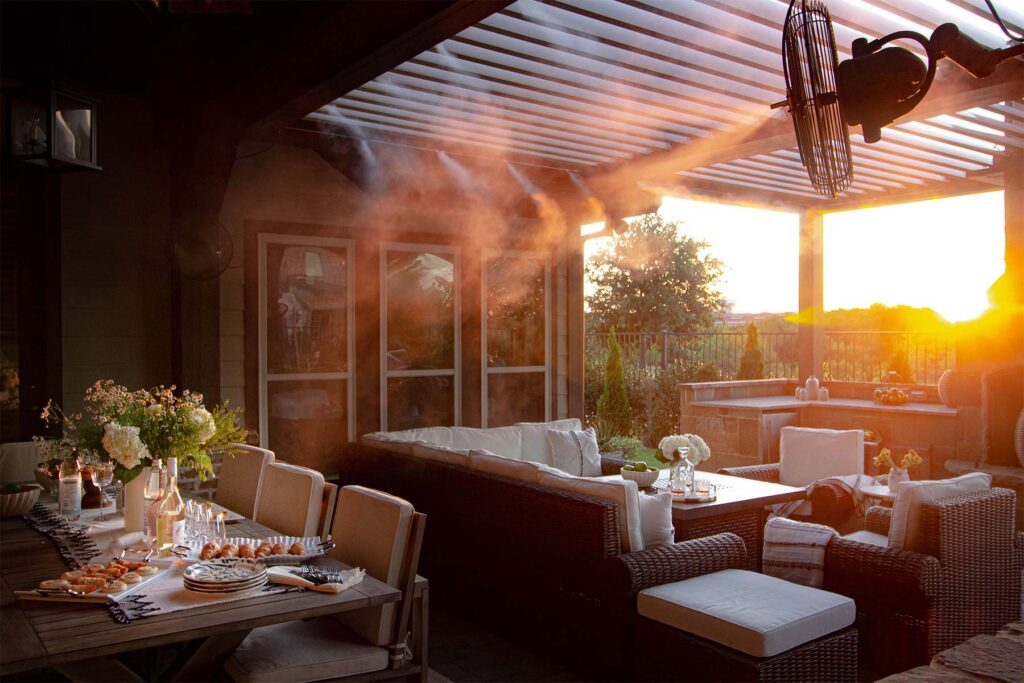
Evaporative cooling is a fascinating process that is used to cool indoor and outdoor spaces in hot and dry climates. Unlike traditional air conditioning systems that rely on refrigerants and compressors, evaporative cooling uses water to cool the air, making it an eco-friendly and energy-efficient alternative.
So, how does evaporative cooling work? The principle is simple – water absorbs heat as it evaporates. When you sweat, your skin feels cooler because the sweat evaporates, taking the heat away from your body. Evaporative cooling systems work in a similar way, but on a larger scale.
An evaporative cooling system comprises a water tank, a pump, and a fan. The pump circulates water from the tank to a wet pad or panel that is usually located at the back of the unit. The fan draws hot, dry air from the outside through the wet pad, where the air is cooled as the water evaporates. The cool air is then distributed back into the space by the fan.
The cooling effect of evaporative cooling systems is directly related to the humidity level of the air. The drier the air, the better the cooling effect. In humid climates, the cooling effect is reduced because the air contains more moisture, making it less able to absorb additional moisture from the wet pad.
Evaporative cooling systems come in two main types: direct and indirect. Direct evaporative cooling systems use water to cool the air directly, while indirect systems use a heat exchanger to cool the air indirectly. Indirect evaporative cooling systems are used in situations where the air needs to be completely free of moisture, such as data centers and laboratories.
In conclusion, evaporative cooling is a natural and efficient way to cool indoor and outdoor spaces. It uses water to cool the air, making it an eco-friendly and energy-efficient alternative to traditional air conditioning systems. Evaporative cooling systems come in different shapes and sizes, making them suitable for a wide range of applications.
Advantages and Disadvantages of Using an Evaporative Cooling System
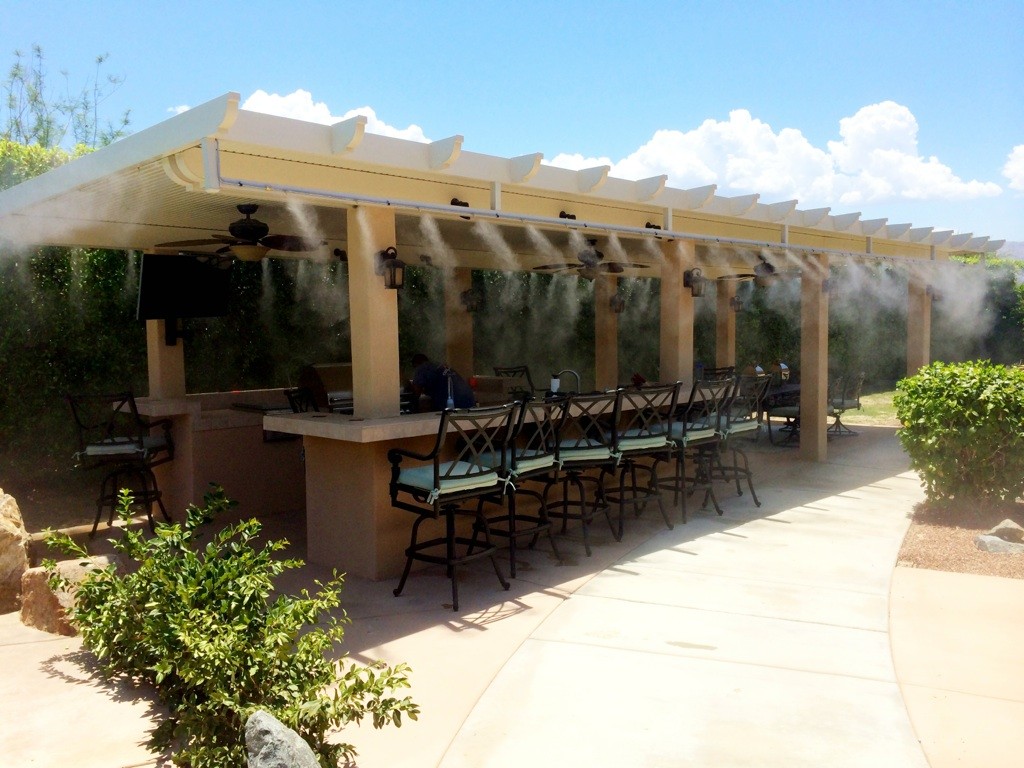
Evaporative cooling systems are becoming more popular as an alternative to traditional air conditioning systems. But as with any cooling system, there are advantages and disadvantages to using an evaporative cooling system.
Advantages:
1. Energy Efficient – Evaporative cooling systems use far less energy than traditional air conditioning systems. They don’t require the same amount of electricity to power the system, so they’re a good option for people who want to save money on their energy bills.
2. Eco-Friendly – Evaporative cooling systems don’t use refrigerants that can contribute to global warming, so they’re more eco-friendly than traditional air conditioning systems.
3. Improved Air Quality – Evaporative cooling systems can improve air quality by increasing humidity levels. They can reduce allergies, asthma, and other respiratory issues as they can help keep air dust and pollen-free.
4. Low Maintenance – Evaporative cooling systems are relatively easy to maintain. There are fewer parts that can break, so they don’t require as much maintenance as traditional air conditioning systems.
Disadvantages:
1. Limited Effectiveness – Evaporative cooling systems work best in dry climates where humidity levels are low. They don’t work as well in more humid climates as the air is already saturated with moisture, and the system can’t add more.
2. Water Usage – Evaporative cooling systems rely on water to work, which can be a disadvantage in areas where water is scarce and droughts are common. These systems require a steady supply of water, which can be a strain on resources.
3. High Humidity Levels – Evaporative cooling systems can increase the humidity level in a building or room. This can be uncomfortable for some people, especially during the hot summer months.
4. Limited Cooling Capacity – Evaporative cooling systems generally have a limited cooling capacity when compared to traditional air conditioning systems. This means they may not be able to keep up in extreme heat conditions.
In conclusion, evaporative cooling systems have both advantages and disadvantages. Before deciding to install an evaporative cooling system, it’s important to consider your climate and water availability. But for those who live in dry climates, they can prove to be an effective, energy-efficient, and eco-friendly option for cooling your home or business.
Factors to Consider When Choosing an Evaporative Cooling System for Your Home or Business
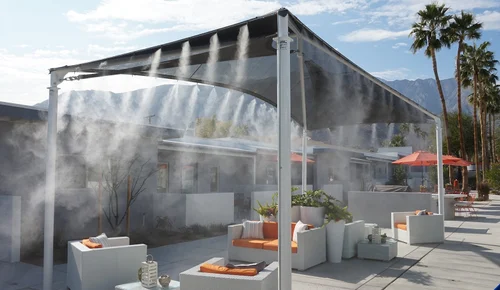
When it comes to air conditioning systems, evaporative cooling is a popular choice for many homeowners and businesses. These systems work by using water to cool down the air, making them more energy-efficient and cost-effective than traditional air conditioning. However, with so many options on the market, choosing the right evaporative cooling system for your specific needs can be a challenge. Here are some factors to consider when making your decision:
1. Climate: Your climate plays a significant role in determining the effectiveness of an evaporative cooling system. These systems work best in areas with low humidity, as they rely on the evaporation of water to cool down the air. If you live in a more humid climate, you may want to opt for a different type of air conditioning system.
2. Space: Consider the size of the space you need to cool down. Evaporative cooling systems are best suited for smaller areas, such as bedrooms or smaller offices. If you need to cool down a larger area, you may need to install multiple evaporative cooling units or consider a larger system.
3. Water source: Evaporative cooling systems require a steady supply of water to function properly. If you live in an area with water restrictions or shortages, you may need to consider alternative cooling systems.
4. Maintenance: Like any piece of equipment, evaporative cooling systems require regular maintenance to function at their best. Consider the level of maintenance required for different systems before making your decision.
5. Noise level: Some evaporative cooling systems can be quite noisy, particularly if they use high-pressure systems. Consider the noise level of different systems, particularly if you plan to use them in a bedroom or other quiet space.
6. Energy efficiency: Look for systems that are energy-efficient, as these will help reduce your energy bills and may even qualify for government rebates.
Overall, choosing the right evaporative cooling system for your home or business requires careful consideration of your specific needs and the factors outlined above. With the right system, you can enjoy cool, comfortable air without breaking the bank or harming the environment.
Water Droplets & Spray of Water
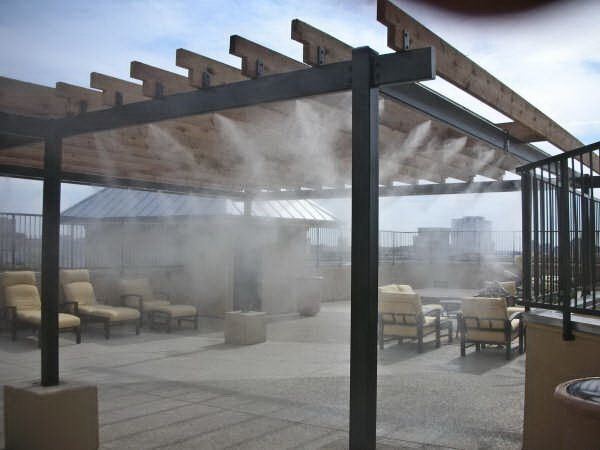
When it comes to outdoor cooling systems, water droplets and a spray of water are often a key component. These droplets and sprays are created by misting systems, which use specialized nozzles to turn water into an ultra-fine mist. This mist is then released into the air, where it quickly evaporates, creating a cooling effect.
There are two main types of misting systems: high-pressure and low-pressure. High-pressure systems use pumps to create water pressure of up to 1000 psi, creating a very fine mist that can cool the air by up to 30 degrees Fahrenheit. These systems are often used in theme parks and other large outdoor spaces where maximum cooling is required.
Low-pressure misting systems, on the other hand, use gravity-fed water pressure to create a finer mist that can cool the air by up to 20 degrees Fahrenheit. These systems are often used on outdoor patios and other smaller outdoor spaces where a more efficient cooling system is required.
Both high-pressure and low-pressure misting systems can create water droplets and a spray of water, so it’s important to understand how these systems work before deciding which one is best for your needs. While the cooling effect of misting systems is undeniable, it’s important to note that they can also create water deposits on outdoor furniture and other surfaces, which may require additional cleaning.
Overall, if you live in a hot and humid climate and are looking for an effective way to cool down your outdoor living space, a misting system may be the perfect solution. Whether you choose a high-pressure or low-pressure system, the drop in temperature and efficient cooling provided by water droplets and a spray of water will make your outdoor time much more enjoyable.
What are Water Droplets?
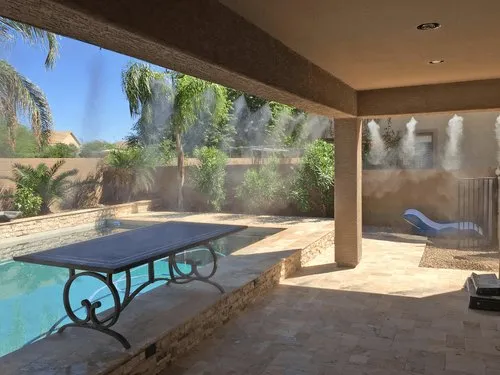
Water droplets are small spherical or oblong-shaped droplets of water that form when water vapor condenses or precipitates from the atmosphere. They can range in size from just a few micrometers to several millimeters and can be seen in clouds, fog, mist, and rain.
Water droplets form when water molecules in the atmosphere come together and stick to each other, creating tiny droplets. This process is called condensation. The temperature and humidity levels in the atmosphere play a significant role in how easily water droplets form. When the air is humid, there is more vapor in the atmosphere, which increases the chances of water droplets forming.
Water droplets are also an important component of the water cycle. When water evaporates from the surface of the earth, it rises into the atmosphere as water vapor. As the water vapor cools and condenses, it forms water droplets that eventually fall to the ground as precipitation.
Water droplets can also be seen in outdoor misting systems, which use water to cool the surrounding air. In these systems, water is forced through a fine spray nozzle, creating tiny water droplets that evaporate quickly, removing heat from the surrounding air and creating a cooling effect.
However, while water droplets can be a refreshing sight on a hot day, they can also cause problems. For example, too much moisture in the air can lead to mold growth and cause damage to buildings and other structures. In addition, excessive moisture can cause fog, reducing visibility on roads and other areas.
In conclusion, water droplets are a natural phenomenon that occurs when water molecules in the atmosphere come together and form tiny droplets. They play an important role in the water cycle and are also used in outdoor misting systems to cool the air. Understanding the nature of water droplets can help us appreciate their beauty and also manage any potential problems associated with them.
How Does a Spray of Water Work?
A spray of water is a powerful and versatile tool with a wide range of applications, from cooling outdoor spaces to cleaning surfaces and even putting out fires. But how does a spray of water actually work?
At its most basic, a spray of water is simply a nozzle that forces water through a small opening, creating a high velocity stream of water droplets. The size of the opening and the pressure of the water determine the size and velocity of the droplets.
In outdoor misting systems, for example, low-pressure misting uses larger droplets that provide a cooling mist without getting everything wet, while high-pressure misting creates a finer mist that is more effective at cooling, but which can also create a lot of water droplets that can wet surfaces.
Another factor that affects the size and velocity of water droplets is the geometry of the nozzle itself. Different types of nozzles can create different spray patterns, including fans, cones, and solid streams.
One of the most important factors in creating an effective spray of water is the pressure of the water supply. A higher pressure can create smaller and more powerful droplets that are able to penetrate surfaces and dislodge dirt and grime.
In firefighting, a high-pressure spray of water can be used to douse flames, while in agriculture, sprinklers and other types of irrigation systems use a spray of water to keep crops hydrated and healthy. Industrial cleaning applications often use specialized nozzles and high-pressure water to remove tough stains and clean hard-to-reach surfaces.
Of course, a spray of water also has its drawbacks. If used in excessive amounts or in the wrong conditions, it can lead to water damage and mold growth. And while it can be an effective tool for cooling outdoor spaces, a spray of water can also create humidity and damp conditions that are not always desirable.
Overall, though, a spray of water is a simple but powerful tool that can be harnessed for a wide range of applications, from cooling and cleaning to firefighting and irrigation. By understanding how a spray of water works, we can make the most of its many capabilities while avoiding its potential drawbacks.
Advantages and Disadvantages of Spraying Water on Hot Surfaces
Spraying water on hot surfaces may seem like a quick and easy way to cool things down, but there are both advantages and disadvantages to this method.
Advantages:
1. Instant cooling – Spraying water on a hot surface can provide instant relief from the heat. The water absorbs the heat and evaporates, taking away some of the heat from the surface.
2. Low cost – The cost of spraying water on hot surfaces is relatively low compared to other cooling methods. It does not require any additional equipment or energy consumption.
3. Environmentally friendly – Spraying water on hot surfaces is an environmentally friendly way to cool things down. Unlike air conditioning units, it does not emit any harmful chemicals or contribute to global warming.
Disadvantages:
1. Water damage – Excessive spraying of water on hot surfaces can cause water damage to floors, walls, and ceilings. This can lead to structural damage if not addressed promptly.
2. Slippery surfaces – When water is sprayed on hot surfaces, it creates a wet surface which can be slippery and hazardous. This can increase the risk of accidents and injuries.
3. Increased humidity – Moisture from spraying water on hot surfaces can create a humid environment which can be uncomfortable for people. High humidity levels can also damage electronic equipment and accelerate corrosion on metal surfaces.
4. Wastage of water – While spraying water on hot surfaces does not require expensive equipment, it does use a considerable amount of water. In areas where water is scarce, this can be a concern.
In conclusion, while spraying water on hot surfaces may provide a quick solution to hot environments, it is important to weigh the advantages and disadvantages before using this method. Consider other cooling methods that may be more effective and efficient, and always be mindful of any potential risks and hazards.

